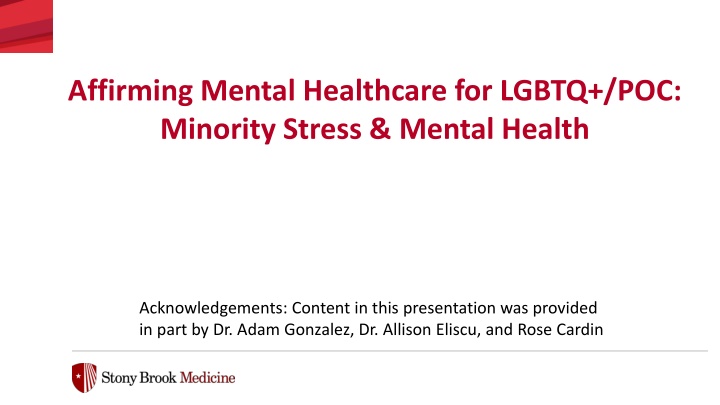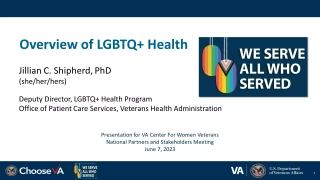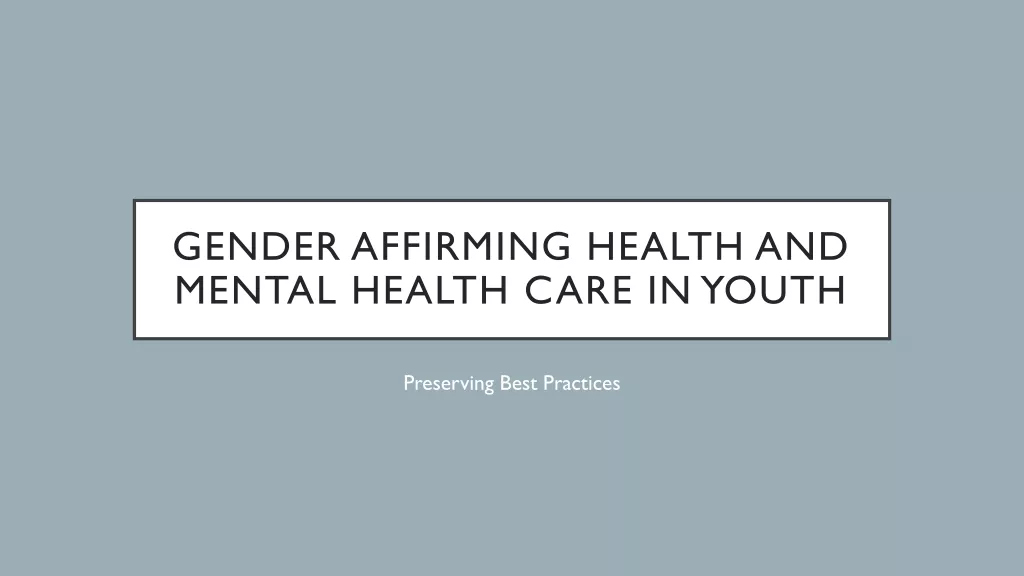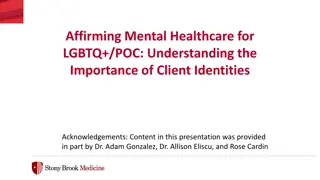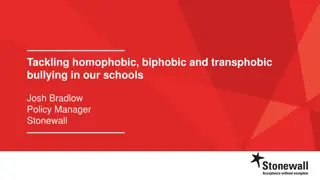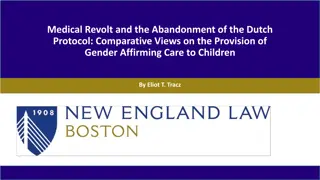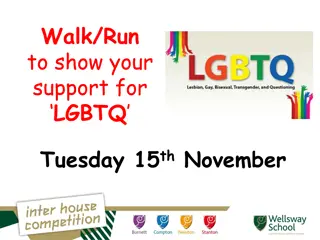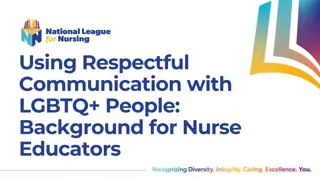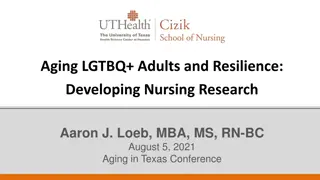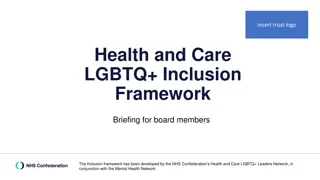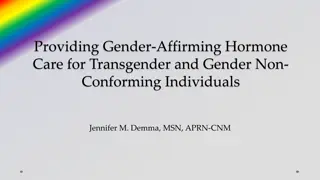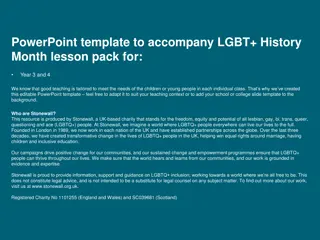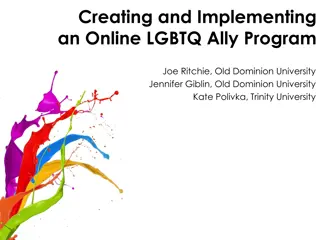Affirming Mental Healthcare for LGBTQ+/POC: Addressing Barriers and Health Disparities
This presentation highlights the challenges faced by LGBTQ+ and POC individuals in accessing mental healthcare, including insufficient provider knowledge, negative attitudes, financial difficulties, and stigma. It also discusses the impact of minority stress on mental health, emphasizing the importance of comprehensive care and support for transgender and gender-diverse individuals, as well as addressing significant health disparities among LGBTQ+ youth. The data presented underscores the need for culturally competent and affirming mental health services for marginalized communities.
Download Presentation

Please find below an Image/Link to download the presentation.
The content on the website is provided AS IS for your information and personal use only. It may not be sold, licensed, or shared on other websites without obtaining consent from the author.If you encounter any issues during the download, it is possible that the publisher has removed the file from their server.
You are allowed to download the files provided on this website for personal or commercial use, subject to the condition that they are used lawfully. All files are the property of their respective owners.
The content on the website is provided AS IS for your information and personal use only. It may not be sold, licensed, or shared on other websites without obtaining consent from the author.
E N D
Presentation Transcript
Affirming Mental Healthcare for LGBTQ+/POC: Minority Stress & Mental Health Acknowledgements: Content in this presentation was provided in part by Dr. Adam Gonzalez, Dr. Allison Eliscu, and Rose Cardin
LGBTQ+/POC Face Many Barriers To Care Insufficient provider knowledge Negative provider attitudes Financial difficulties Stigma/discrimination Lack of appropriate health education 56% LGB and 70% Transgender adults have experienced discrimination in health care1 49% LGB and 89% Transgender adults believe not enough medical professionals appropriately trained to treat their issues1 1 in 4 transgender adults avoided a necessary medical visit because of fear of being mistreated2 1 Lambda Legal. When Health Care Isn t Caring. 2010 2 SE James, et al. Report of the 2015 U.S. Transgender Survey. National Center for Transgender Equality 2016 2
LGBTQ+ Youth Disclosure Percent of LGBTQ Youth Out Regarding Sexual Orientation Out Regarding Gender Identity 0 20 40 60 80 100 0 10 20 30 40 50 60 70 80 90 100 Friend Friend Parent Parent Sibling Teacher Sibling Teacher Stranger Stranger Grandparent/relative Grandparent/relative Doctor/Medical Provider Coworker 25% 29% Doctor/Medical Provider Coworker Religious Community Religious Community Coach Coach Out to Some Out to All Out to Some Out to All 2018 LGBTQ Youth Report Human Rights Campaign Foundation
Minority Stress Model Identifying as transgender or sexual minority is not a mental health disorder External stressors & stigma Discrimination Violence Rejection Inadequate resources Limited mental health services Medical providers lack LGBTQ experience Internal stressors Conceal self-identity Internal conflict Isolation Low self-esteem Anxiety, Depression, Substance use Physical and Mental Health Issues Ensuring Comprehensive Care and Support for Transgender and Gender-Diverse Children and Adolescents AAP Policy Statement 2018
LGBTQ+ Face Significant Health Disparities Student Survey 9th and 11th graders, n=81,885 Trans/Non- Conforming Youth n=2,168 (2.7%) Health Risk Behavior Cis Youth Alcohol use 23% 17% No condom at last sex 51% 38% Depressive symptoms 58% 21% Self-harm past year 54% 14% Suicidal Ideation 61% 20% Experienced gender-based prejudice 35% 5% Experienced gender expression-based prejudice 47% 15% Eisenberg, Gower, McMorris, Rider, Shea and Coleman. J Adolesc Health 2017.
LGBTQ+ Face Significant Health Disparities Student Survey 9th and 11th graders, n=81,885 Trans/Non- Conforming Youth n=2,168 (2.7%) Health Risk Behavior Cis Youth Alcohol use 23% 17% No condom at last sex Protective factors: 51% 38% Depressive symptoms 58% 21% Family connectedness Self-harm past year 54% 14% Student-teacher relationships Suicidal Ideation 61% 20% Feel safe in community Experienced gender-based prejudice 35% 5% Experienced gender expression-based prejudice 47% 15% Eisenberg, Gower, McMorris, Rider, Shea and Coleman. J Adolesc Health 2017.
LGBTQ+ Health Disparities: Youth Gay, Lesbian, Bisexual 9th-12th graders Heterosexual 9th-12th graders Ever forced to have intercourse 6% 19% Been electronically bullied (prior 12 months) 14% 27% Used pain medication without Rx 13% 24% Felt sad/hopeless almost daily for 2 weeks and stopped doing usual activities 32% 66% Had serious suicidal ideations (within prior 12 months) 15% 47% Attempted suicide (within prior 12 months) 6% 23% CDC Youth Risk Behavior Surveillance 2019
LGBTQ+ Health Disparities: Youth LGB youth are at increased risk for suicidal ideation (3x), attempted suicide (4x), and depression Few studies also suggest the same is true for transgender youth. Risk Factors include: sexual-minority status, homophobic victimization and stress, and family rejection Compared with heterosexual youth, LGB youth report greater rates of: Disordered eating Child abuse School bullying Sexual violence High risk sexual activity Smoking Alcohol use Everett, B., & Mollborn, S. (2013). Differences in hypertension by sexual orientation among U.S. young adults. Journal of Community Health, 38(3), 588 596. IOM. (2011). The Health of Lesbian, Gay, Bisexual, and Transgender People: Building a Foundation for Better Understanding
LGBTQ+ Health Disparities: Adults Lesbian/bisexual adult women have greater risk of: Breast cancer Obesity Cardiovascular disease Depression Suicide Gay adult men have greater risk of: Eating disorders Erectile dysfunction Anal cancer HIV infection IOM. (2011). The Health of Lesbian, Gay, Bisexual, and Transgender People: Building a Foundation for Better Understanding.
2021 LGBTQ* Health Needs Assessment Survey Eligible: LGBTQ* adults (ages 18+) living in or attending college/university/technical school in Suffolk or Nassau County Online snowball sampling Collaboration with >30 Long Island partners IRB approved June September 2021 Goal: 1,000 surveys by September 30th Achieved 1,150 valid, completed surveys
Comparisons to Suffolk County, New York State, and National Data When adjusted to account for sample differences, LGBTQ* respondents fare worse than the county, state, or nation for: Lack of Health Insurance Cost as a Barrier to Doctor Visits Travel Time/Distance as a Barrier to Medical Care Routine Checkups 1 1
LGBTQ* Mental Health Status 43.6% 37.5% 35.2% 33.5% 23.9% Fair/Poor Mental Health Moderate to Severe Anxiety/Depression Thoughts of Self- Harm in Past 3 Yrs Seriously Considered Suicide in Past 3 Yrs Currently Being Treated for Mental Health Sources: 2021 LGBTQ+ Community Health Needs Survey, PRC, Inc. Notes: Asked of all respondents. 1 2
Have Ever Been Treated Disrespectfully or in a Non-Affirming Way by Any Health Care Provider or Their Office Staff 60.3% 52.5% 52.4% 50.3% 47.2% 44.2%40.9% 42.3% 41.9% 42.3% 40.9% 39.1%37.3%32.1% 38.2%35.1%28.0% 37.0% 33.4%36.1% 33.5%29.1% 29.3% 24.1% 23.4% 24.0% Sources: 2021 LGBTQ+ Community Health Needs Survey, PRC, Inc. Notes: Reflects all respondents. "Identities <50" includes respondents identifying with various sexual identity terms mentioned by fewer than 50 respondents each. 1 3
Highly Important Issues for LGTBQ* People in Nassau/Suffolk Counties Behavioral Health 95.9% 94.9% 93.3% 93.1% 91.5% 91.3% 88.2% 87.3% 87.0% 86.5% 83.4% 83.2% Training Providers About LGBTQ+ Health Insurance Coverage for LGBTQ+ Care Access to Affirming Care Suicide/Self-Harm Violence/Emotional Abuse in Families/Relationships Bullying/Harassment Violence - Hate Crimes Racism STIs (Including HIV/AIDS) Housing/Homelessness Mistreatment in Criminal Justice Sources: Notes: Reflects respondents rating items as 8, 9, or 10 on a 10-point scale where 10 is highest importance. Respondents were asked about importance in the specific county in which they live. 2021 LGBTQ+ Community Health Needs Survey, PRC, Inc. 1 4
LGBTQ* HEALTH NEEDS SURVEY Thank for this survey. Keep doing this! Doctors and medical personnel need to understand that assumptions made regarding a patient's sexual orientation or gender identity are harmful. When care is taken, we feel truly seen by the people in our lives who we trust to oversee our health. That means everything. amazing to know someone is taking interest and trying to make healthcare better for our community.
